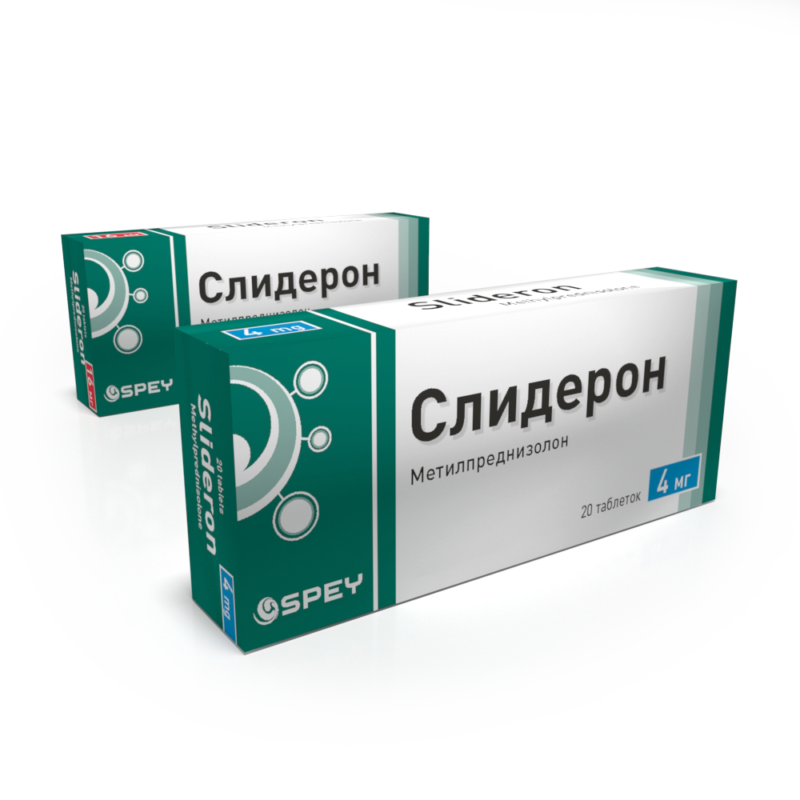
Slideron
Glucocorticoids, including Slideron, improve the antiemetic efficacy of other antiemetic drugs used concomitantly with anticancer drugs that induce vomiting.
Composition
1 tablet contains:
active substance: methylprednisolone 4 mg or 16 mg,
excipients: lactose monohydrate and corn starch (85: 15), colloidal anhydrous silicon dioxide, magnesium stearate
Indications for use
– replacement therapy for endocrine diseases (primary and secondary adrenal insufficiency, congenital adrenal hyperplasia);
For symptomatic treatment (as part of complex therapy):
-addition to supportive patience, for short-term use in acute rheumatic diseases (or their exacerbation), such as psoriatic arthritis, rheumatoid arthritis, including juvenile rheumatoid arthritis, ankylosing spondylitis, acute and subacute bursitis, acute nonspecific arthritis postraumatic arthritis , synovitis with osteoarthritis, epicondylitis – with exacerbation or as maintenance therapy of systemic lupus erythematosus, systemic dermatomyositis (polymyositis), acute rheumatic carditis and giant cell arteritis;
– skin diseases (pemphigus, bullous herpetiformis dermatitis, Stevens-Johnson syndrome, exfoliative dermatitis, fungoid mycosis, severe psoriasis, severe seborrheic dermatitis);
-control of severe allergic conditions that are not amenable to conventional treatment (seasonal or non-seasonal allergic rhinitis, serum sickness, bronchial asthma, drug disease, contact and atopic dermatitis);
-severe acute and chronic allergic and inflammatory processes of the eye and its appendages (allergic marginal corneal ulcers, ocular form of herpes zoster, inflammation of the anterior segment of the eye, diffuse posterior uveitis and choroiditis, sympathetic ophthalmia, allergic conjunctivitis, keratitis, neuritis and chorioretinum nerve);
– pulmonary sarcoidosis, refractory Leffler syndrome, berryliosis, acute disseminated pulmonary tuberculosis (in combination with anti-tuberculosis drugs), aspiration pneumonitis;
– blood diseases such as idiopathic thrombocytopenic purpura and secondary thrombocytopenia (in adults, acquired (autoimmune) hemolytic anemia, erythrocytic anemia, congenital hypoplastic anemia;
-palliative treatment of leukemia and lymphoma (in adults), acute blast leukemia (in children);
– severe exacerbation of ulcerative colitis and Crohn’s disease;
– exacerbation of widespread sclerosis and edema associated with a tumor in the brain;
– tuberculous meningitis with subarachnoid blockade or threatening blockade (in combination therapy with anti-tuberculosis drugs)
trichinosis with brain or myocardial damage;
– to suppress the reaction of graft rejection;
nephrotic syndrome (non-uremia, idiopathic, or associated with systemic lupus erythematosus) – to stimulate urine output or reduce proteinuria.
Mode of application
The starting dose depends on the disease and its severity. The dose should be reduced when a positive clinical response is achieved. The maintenance dose should be minimal, for adults it is usually 4–12 mg per day, taken in one dose in the morning. Lower doses are recommended for children. With long-term treatment, taking the drug can be prescribed every other day, once in the morning.
4 mg methylprednisolone is equivalent to 5 mg prednisolone, 4 mg triamcinolone, and 0.75 mg dexamethasone.
Pediatric dosage is based on clinical response. Treatment should be carried out with the lowest effective dose for the shortest period of time. In case of adrenal insufficiency, orally 0.14 mg / kg or 4 mg / m2 per day in 3 doses, for other indications – inside 0.417-1.67 mg / kg or 12.5-50 mg / m2 divided into three doses. If possible, the daily dose should be taken once every other day.